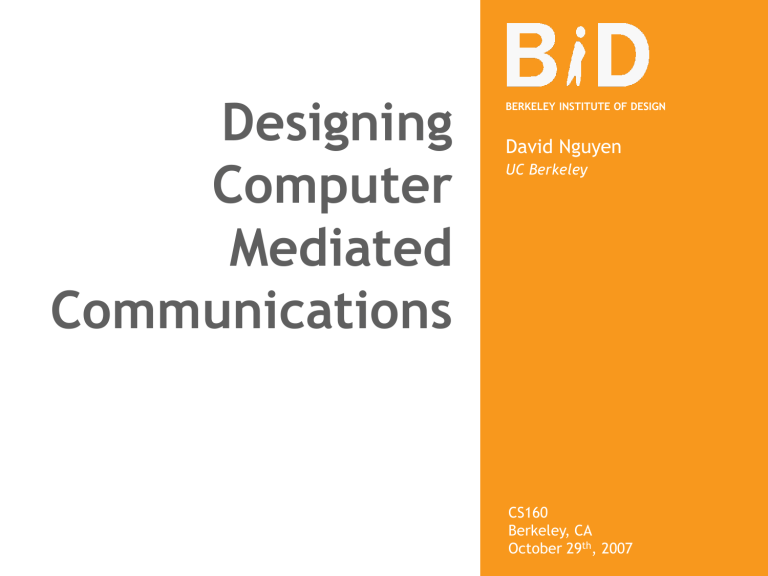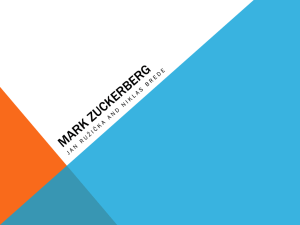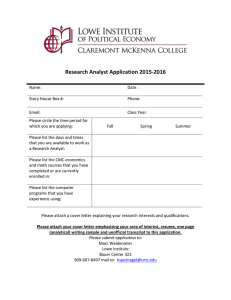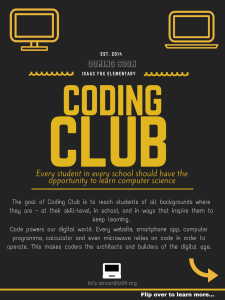Designing Computer Mediated Communications

Designing
Computer
Mediated
Communications
BERKELEY INSTITUTE OF DESIGN
David Nguyen
UC Berkeley
CS160
Berkeley, CA
October 29 th , 2007
My Lab
My Lab Mates
My Research
My Teachings
My Extra Time
My University
My Expectations
• Everyone will
– focus on the presentation
– want to answer questions
– have questions to ask
– want to participate in the exercises I have planned.
– laugh at my jokes
• Introduction
• CMC and Trust
• User Generated Content and the Tragedy of the Commons
• Social Networking and Presentation of Self
• Where do we go from here?
CMC Systems
Computer Mediated
Communications
Psychology Social cognition, interpersonal perception, attraction
Sociology Group dynamics, social structure, reputation, trust
Communication Mediation, signaling, media richness
HCI Interfaces for social interaction
Social Theory vs.
User-Centered Design
NEEDS
DESIGN
EVALUATE IMPLEMENT
• Introduction
• CMC and Trust
• User Generated Content and Collective
Action
• Social Networking and Presentation of Self
• Where do we go from here?
Common CMC Systems
If you had to negotiate a $1 million deal, how would you do it?
Trust
“Trust reduces the need for costly control structures, thus enabling exchanges that could otherwise not take place, and makes social systems more adaptable.”
(Uslaner 2002, quoted in Riegelsberger et al. 2007 )
What is Trust?
Optimism
Risk
Potential for Betrayal http://plato.stanford.edu/entries/trust/
How do you measure trust?
Prisoner’s Dilemma
• You and your partner each have a chocolate.
• Both you and your partner must independently decide whether or not you want to keep your chocolate or share your chocolate.
2 – No Trust
3 – Half Trust
4 – Full Trust
Prisoner’s Dilemma and
Conditions of Trust
• Risk – by sharing my candy, I
risk losing it all
Potential for Betrayal by betraying me, my partner stands to gain by getting a lot of candy
• Optimism – I am not sure my partner will share with me.
Trust Formation
(Bos et al., 2002)
• Trust development was delayed in audio/video
• Defections were more likely with video/audio than FTF communication.
• Little difference between video and audio
Common CMC Systems
If face-to-face is so good, why even have the others?
Trust Measurement vs.
User-Centered Design
NEEDS
DESIGN
EVALUATE IMPLEMENT
• Introduction
• CMC and Trust
• User Generated Content and Collective
Action
• Social Networking and Presentation of Self
• Where do we go from here?
WikiPedia
YouTube
BitTorrent
Where does all that “stuff” come from?
Public Good
Tragedy of the Commons
“If all individuals do A, every individual as a member of the community would derive a certain advantage. But now if all individuals less one continue to do A, the community loss is very slight, whereas the one individual refraining makes a personal gain far greater than the loss that he incurs as a member of the community.” --Pareto 1935, vol. 3, sect. 1496, pp. 946-7
What happens if EVERYONE thinks this way?
User Generated Content
“In most online communities, 90% of the users are lurkers who never contribute,
9% of the users contribute a little, and 1% of users account for almost all the action.” – Jacob Nielsen, 2006
Designing User Generated
Content Systems
• As is, expect about 1% of users to contribute most of your content. Don’t count on more!
• Though it’s only 1% of your users who are contributing content, you’d better make sure that the contribution system is damn good!
• If that won’t work for you, you need to build in incentive systems (payment, recognition, entertainment)
Amazon.com
Entertainment: Peekaboom
Peekaboom
In the FIRST 30 days, 14,153 people played this game
These people generated 1,122,998 pieces of data.
Each person tagged an average of 160 images.
Top 10 scorers averaged 53 hours of game play for one month.
Collective Action vs.
User-Centered Design
NEEDS
DESIGN
EVALUATE IMPLEMENT
• Introduction
• CMC and Trust
• User Generated Content and Collective
Action
• Social Networking and Presentation of
Self
• Where do we go from here?
“All the world’s a stage, and all the men and women merely players.”
Erving Goffman
Presentation of Self
I am hip
He’s so hip
He’s so lame
I’m wearing jeans
• Sept 5, 2006 – Facebook introduces a new feature called “News Feeds”
• Sept 5, 2006 – “Students Against Facebook
News Feeds” forms with over 700,000 members (the largest at the time).
• Sept 5, 2006 – Mark Zuckerberg told everyone to calm down.
“This is information people used to dig for on a daily basis, nicely reorganized and summarized so people can learn about the people they care about.”
“Your friends can still see [your activity]; it hasn't changed.”
• Sept 5, 2006 – Facebook introduces a new feature called “News Feeds”
• Sept 5, 2006 – “Students Against Facebook
News Feeds” forms with over 700,000 members (the largest at the time).
• Sept 5, 2006 – Mark Zuckerberg told everyone to calm down.
• Sept 8, 2006 – Mark Zuckerberg sends out message apologizing and introduces privacy control
• Present – Everyone seems pretty happy
Presentation of Self vs.
User Centered-Design
NEEDS
How could Mark
Zuckerberg have avoided all of this?
DESIGN
EVALUATE
IMPLEMENT
• Introduction
• CMC and Trust
• User Generated Content and Collective
Action
• Social Networking and Presentation of Self
• Where do we go from here?
Augmented Reality
Virtual Worlds
• There’s still a lot of technology out there.
How are they going to affect the way we communicate?
• There’s a lot of ways people communicate out there. How can we design technology to support that?
Questions?
David Nguyen nguyendt@eecs.berkeley.edu


